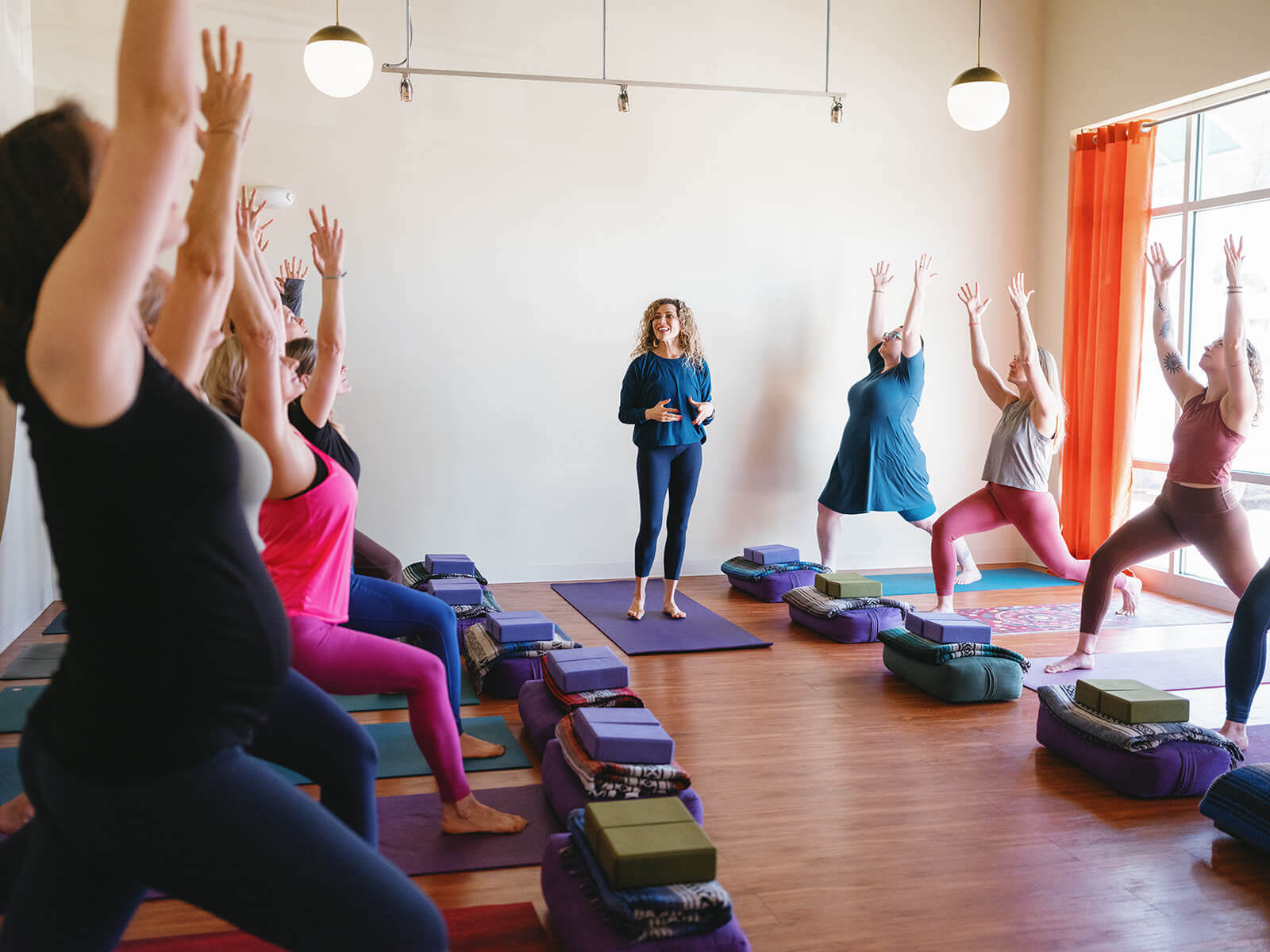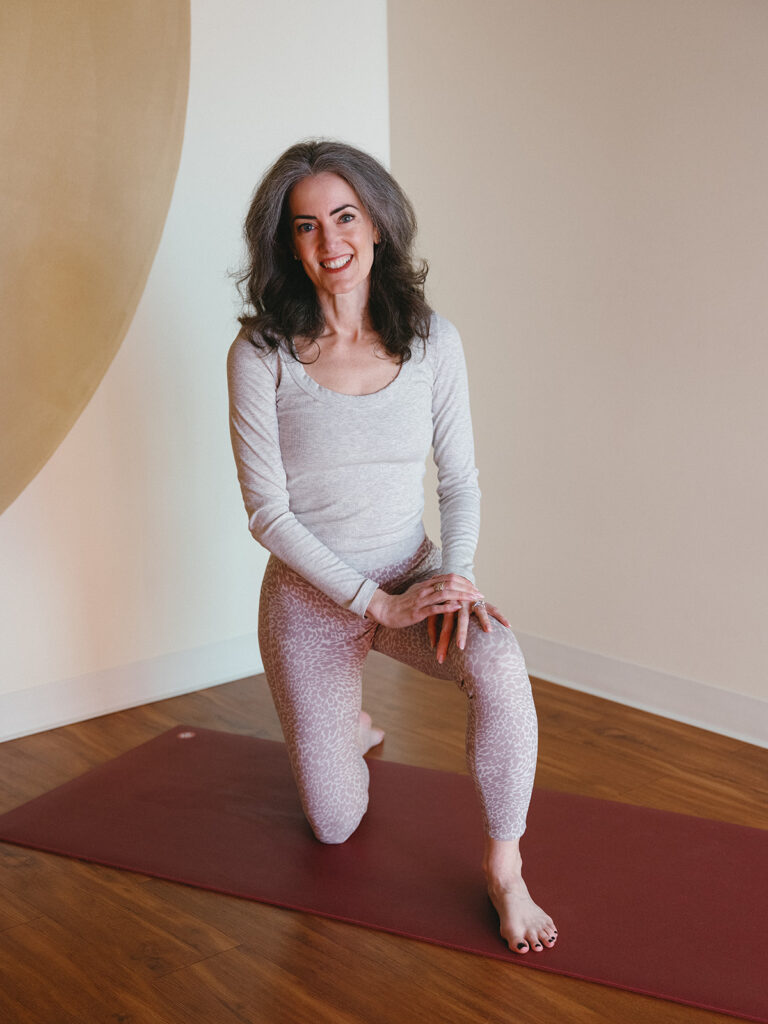Teaching yoga in a small space is something almost every yoga teacher will face at some point. Whether you’re working in the corner of a gym, inside a tight community room, or even in someone’s living room, limited space can feel like a real challenge. But a small room doesn’t have to limit the depth or impact of your teaching! In fact, working within a small footprint can actually sharpen your skills, foster connection, and push your creativity in surprising ways.
Assess the Room Before You Begin
Before class even starts, take a clear-eyed look at your space. What are its true dimensions? Are there immovable objects like furniture, columns, or radiators that need to be factored in? What’s the ventilation and lighting like?
In ideal conditions, each student’s mat needs about 24 square feet—roughly a six-foot by four-foot space—to fully extend arms and legs without bumping into a neighbor. But in reality, many of us work with less than that. Knowing this upfront helps you decide on realistic capacity and make any necessary adjustments.
Rethink Your Mat Arrangements
We often default to arranging mats in neat rows facing the teacher, but that’s not always the best use of space. Get creative!
- Staggered grid: Offset each row so that shoulders don’t line up directly behind one another, giving students extra space to move their arms side to side.
- Diagonal setup: Angling mats at 45 degrees to the walls can often make better use of corners and allow more breathing room between students.
- Circular layout: For small groups, consider having students face inward in a circle. This maximizes edge space and creates a sense of community and equality.
If you’re teaching regularly in the same tight room, consider marking the floor with small, discreet stickers to show students where to place their mats. This eliminates guesswork and prevents the slow “mat creep” where everyone inches a little further apart each week.
Design Sequences That Stay Compact
Not every pose or sequence is small-space friendly. Wide-stance poses like Warrior II or Half Moon need lots of lateral room. Mandala flows or large, circular transitions can end up with people bumping into one another.
Instead, think about:
- Narrow stance postures like Mountain Pose, Chair Pose, or Warrior I.
- Vertical movements that lift energy up and down, rather than wide to the sides.
- Mat-bound sequences that keep students within their personal footprint — for example, flowing between Down Dog, Plank, Cobra, and Child’s Pose. Just be sure to turn everyone to face the long edge of the mat and do wide-stance poses like Warrior II for balance.
- Stationary variations that explore multiple upper-body movements without moving the feet, such as adding twists or side bends while standing in place.
When teaching balances or more wobbly shapes like Half Moon or Tree Pose, suggest that students practice near a wall for extra stability. This reduces the risk of someone toppling into a neighbor. You may need to implement a rotation if the wall space is limited—that’s OK!
Manage Props with Intention
Props can be both a blessing and a curse in small spaces. While they enhance the practice, they can easily become clutter or tripping hazards if not handled thoughtfully.
- Set up essential props ahead of time. This avoids a mid-class scramble when everyone rushes to the shelf at once.
- Choose multipurpose tools. A folded blanket, for instance, can serve as a cushion, bolster, or even a prop for restorative poses.
- Keep it simple. Consider skipping large or bulky props if the room doesn’t comfortably accommodate them.
If you’re regularly teaching in a space where props are limited, you might invest in slim, space-saving versions like half-blocks or thin bolsters.
Watch the Energy and Temperature
Small rooms heat up fast. A space that feels perfectly cozy when students first arrive can become uncomfortably warm once everyone’s moving and breathing.
Be ready to adjust. In cooler weather, it might be fine to start with a few vigorous standing poses to generate warmth. But in a packed, poorly ventilated room, you may want to skip intense flows and opt for slower, more grounded sequences to prevent overheating. Encourage students to dress in layers they can easily remove if needed.
Frame the Experience Positively
One of the biggest gifts of small-space teaching is the sense of shared energy. When students practice close to one another, they often become more attuned to the group’s collective rhythm. This can create a powerful feeling of intimacy and connection.
Rather than focusing on the limitations, draw your students’ attention to the collective experience:
- Invite them to notice the group’s synchronized breath.
- Acknowledge the shared commitment in the room.
- Remind them that even in close quarters, each person’s practice is their own.
For some students, the close proximity might trigger discomfort or anxiety. Explicitly let them know they’re welcome to take breaks, step to the side, or position themselves near an exit if that helps them feel more at ease.
Build Teaching Confidence
Here’s what I’ve found over two decades of teaching: if you can deliver a safe, meaningful class in a cramped or quirky space, you’ll feel prepared to teach anywhere. Small rooms train you to be adaptable, resourceful, and intentional. You learn to make each pose count, each instruction meaningful, and each student feel seen.
These are the same skills that will serve you well in larger or more ideal teaching spaces—and they’re part of what makes a great yoga teacher, regardless of the room.
If you want to explore more about refining your teaching, visit my podcast archive, where I cover topics like class design, sequencing strategies, and building student connection.


